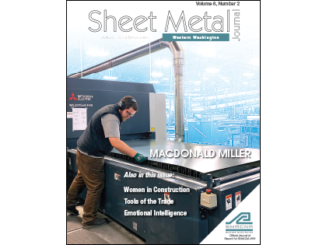
By / Kathleen Collins • SMACNA Legislative Consultant
The Legislature wrapped up its work at the end of April—a session that was unique in many ways. Due to the pandemic, the deliberations were done with a skeleton crew of legislators on the floor and the hearings were all virtual. Yet, the Democrat majority in the House and Senate got a lot done. They passed two Governor priority climate bills, several police reform bills, and spent a lot of state and federal money to mitigate pandemic impacts. This article highlights two new laws—regulation of refrigerants and changes to the state’s long-term care program.
New HFC law
One of the new laws passed in 2021 is an expansion of regulation on hydrofluorocarbons (HFCs) used in air conditioning and refrigeration equipment. The Legislature passed a law in 2019 that requires the use of less polluting refrigerants in commercial equipment. HB 1050 expands the 2019 law to residential and small commercial air conditioning and other refrigeration units starting in 2023. The State Building Code Council will adopt rules defining what substitute products can be used. The new law also requires a safe disposal program and leak detection checks. Ecology is designing an end-of-life disposal program, and contractors can provide comments on the design of the program through Ecology’s HFC end-of-life information page (see below). The new law requires equipment owners to check their equipment for leaks and to hire certified workers to make repairs. We expect Ecology will rely on the existing EPA Technician Certification (Section 608) for the proper handling and disposal of refrigerants. SMACNA contractors will want to make sure their service divisions are ready to undertake this expanded work.
State mandated long-term care insurance
This session, the Legislature amended the state’s long-term care program. (The formal title of the program is the Long-term Services and Supports Trust Program.) This is a state-run program to fund and provide a long-term care benefit to workers in Washington. Long-term care includes non-medical assistance with daily living, as well as assisted living and nursing home care. The state’s long-term care coverage will provide a lifetime benefit of $36,500. The state has been working on implementing the program since it first passed in 2019. Starting January 1, 2022, the Employment Security Department (ESD) will assess a quarterly 0.58 percent payroll tax on all individuals who work in Washington state and have their wages reported on the federal W2 form. The tax will be applied to the pretax amount.
As the program was initially set up, an individual who had long-term care insurance could opt out of the state program until December 31, 2022. This year, the Legislature shortened the opt out timeframe to October 31, 2021. After that date no one will be allowed to opt out. Workers who elect to opt out cannot join the state program in the future, even if they change jobs. The vesting provisions are complicated, but basically a worker must work in Washington for ten years to be eligible for the lifetime benefit.
Employment Security plans to use the Paid Family and Medical Leave (PFML) payroll program provisions as a template for the long-term care payroll deductions. But they won’t be identical. Unlike PFML, there is no wage cap, so higher wage workers will pay more for the same benefit as lower wage workers. Another difference is the long-term payroll tax is paid entirely by the employee. One of the many areas of concern is that the care paid for by the benefit must be provided in the state of Washington. Workers who leave Washington will not be able to use the benefit even though they will have paid for it while they worked here. Also, workers close to retirement age won’t qualify for the program or may only get only limited access due to the vesting requirements.
As mentioned above, there is a time limited opt-out period. However, ESD does not have the opt-out system set up yet. It will become available on October 1, 2021. The employee must be the one to ask for an opt-out. The employer cannot do that for the employee. ESD will send the worker an approval letter if the type of long-term care insurance the person has meets the state’s requirements.
Starting in 2022, SMACNA contractors will have to submit quarterly payments to Employment Security Department for all their employees who are covered. Contractors will need to keep track of the employees who received an approved opt-out and not do a payroll deduction for them. It is the employee’s responsibility to give the employer a copy of their approved opt-out letter from ESD.
SMACNA contractors should understand that the requirements of this program can change in the future. Besides possible legislative adjustments, the state program is governed by a council that has discretion to make changes. For example, the council can increase the payroll tax to ensure adequate funding. Individuals and employers wanting to obtain long-term care insurance to meet the October 31 opt-out deadline will want to act soon. The long-term care insurance industry has started imposing more restrictions on purchase of their products to prevent individuals from buying insurance and then dropping it once the opt-out is approved.
The description provided here does not address all the questions SMACNA contractors will have. This is complicated program, and Employment Security has not completed its rule-making for the 2022 start date, so there are unanswered questions. SMACNA is planning to do a program on this topic, and we will keep you informed of additional information as it becomes available.
HFC End-of-life information: ezview.wa.gov/site/alias__1962/37700/refrigerants_management_program.aspx ▪



